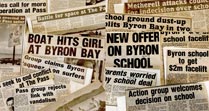WHEN I told a much-loved uncle back in 1983 that we were moving to Byron Bay, he said be very careful because there had been a major radioactive scare in the town.
I don’t know why I wasn’t aware of the story because apparently it had made national headlines and caused major divisions in the town, but I wasn’t.
The man who brought the issue to life in the early 1980s was Frederick Carr, a former employee of the company mining and processing sand at Byron Bay.
Mr Carr alerted Byron Council to the possibility of tailings from local mining being used on the Pacific Vista Estate which was being developed by the council being radioactive.
State Government officials investigated and found low levels of radiation present on the estate.
However, inspectors from the NSW Health Commission said the radiation levels would not be a problem if surface soils were removed.
The council removed the soil and the estate was given the all-clear.
Suspicious that there might be other ‘hot spots’ in the town, Mr Carr carried out his own tests with a Geiger counter and alerted the council about his results.
His concerns were confirmed in January 1982 when the NSW Director of Public Health Services, Dr A Crawford said areas of radioactivity above internationally accepted levels of safety had been found at Byron Bay.
The areas included the Byron Bay Primary School and Byron District Hospital where material containing a radioactive material, monazite had been used as fill.
In a large operation that lasted 12 months and cost more than $1 million, contaminated material was removed from around and under many buildings in the town.
Fred Carr died at the age of 68 at Atherton in Far North Queensland with friends saying cancer was the cause of his death.
Sand mining was started at Byron Bay in 1935 by Zircon Rutile which was taken over by Associated Minerals in 1961.
The industry was a big employer in the town with Tallow Beach, Main Beach, Clarks Beach and Belongil Beach heavily mined.
Sand mining literally changed the shape of Byron Bay’s beachfront with massive dunes disappearing.
Mining finished in 1968, but processing continued for another four years closing down in 1972.
The main processing plant was located where the now empty Woolworths building stands and the area around it.
(NOTE: The information about Fred Carr came from a metropolitan newspaper article I have in my files published after his death.)
